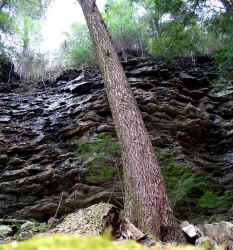Ents,
Big Fiery Gizzard Creek cuts down through the sedimentary rocks
of the
Cumberland Plateau in central Tennessee to produce a narrow
gorge. A
rim of sandstone cliffs, some over 150' high, separate the gorge
from
the adjacent rolling topography, and within the stream courses
over
multiple waterfalls and through narrow, rock-lined chutes. Those
scenic features helped spur the state to acquire part of the
gorge
during the Great Depression and establish a Civilian
Conservation Corp
camp at the site. The property has become Grundy Forest State
Natural
Area, and now features several hiking trails. However, the
natural
area encompasses only 211 or 230 acres (depending on what source
you
read) at the upper end of the gorge.
Photos from Fiery Gizzard by Michael Davie

Shot of the chimneys at Fiery Gizzard
Acidic sandstone underlies most of natural area and provides
favorable
conditions for eastern hemlock, one of which is purported to be
500
years old. The celebrated tree produces a striking image with a
13'2"
cbh trunk adjacent to a deep rock overhang, but the tree's crown
lacks
the gnarl typical of ancient hemlocks. The tree appears closer
to 200
years, which is curiously typical of the hemlocks in the area.
The
hemlocks, and associated hardwoods, clearly predate the advent
of
commercial logging in the area, but conspicuously old appearing
trees
are entirely absent. Consistently high moisture in the gorge
probably
precludes stand clearing fires, and the twists and turns of the
upper
gorge would inhibit wind from flattening more than a few acres
at a
time. Hence, the lack of old trees is perplexing.

A hemlock in front of a cliff at Fiery Gizzard
Literature on the site also mentions a 200 year old buckeye. The
large, columnar, broken-topped tree stands out conspicuously
from the
surrounding forest. The tree grows in a more diverse forest near
the
lower edge of the forest that shows limestone influence. Hemlock
still forms groves, but basswood, tuliptree, sycamore, and
shagbark
hickory, constitute much of the canopy. Umbrella magnolias, with
simple leaves approaching two feet long, form the midstory with
yellow
birch.

Gizzard
falls-one of the waterfalls at Fiery Gizzard
Yellow birch also grow in the acidic forest at the upper end of
the
property, but in that forest they associate with big leaf
magnolia,
which has leaves that routinely exceed two feet long. At the top
of
the gorge, those species give way to a twisted midstory of
American
hollies that stand over large, upright mountain laurel.
Species Cbh Height
Ash, Green NA 119.4'
Ash, Green NA 129.3'
Basswood, White NA 126.6'
Basswood, White NA 127.7'
Beech 10'3" 125.9'
Birch, Yellow NA 86.1'
Buckeye, Yellow NA 130.2'
Hemlock, Eastern NA 125.5'
Hemlock, Eastern NA 135.2'
Hemlock, Eastern NA 147.5'
Hickory, Shagbark NA 138.8'
Magnolia, Cucumber NA 127.7'
Maple, Sugar NA 117.6'+
Oak, Chinquapin 6'3" 109.6'
Oak, Chestnut NA 110.8'
Oak, Northern Red 8'2" 115.6'
Oak, White NA 130.0'
Sourwood 2'5" 90.0'
Stewartia, Mountain 6.5" 22.2'
Sycamore NA 126.6'
Sycamore NA 131.2'
Sycamore NA 140.6'
Tuliptree NA 146.6'
Rucker Index 134.4'
Eastern Hemlock 147.5'
Tuliptree 146.2'
Sycamore 140.6'
Shagbark Hickory 138.0'
Yellow Buckeye 130.2'
White Oak 130.0'
Green Ash 129.3'
White Basswood 127.7'
Cucumbertree 127.7'
Beech 125.9'
Jess Riddle & Michael Davie
|